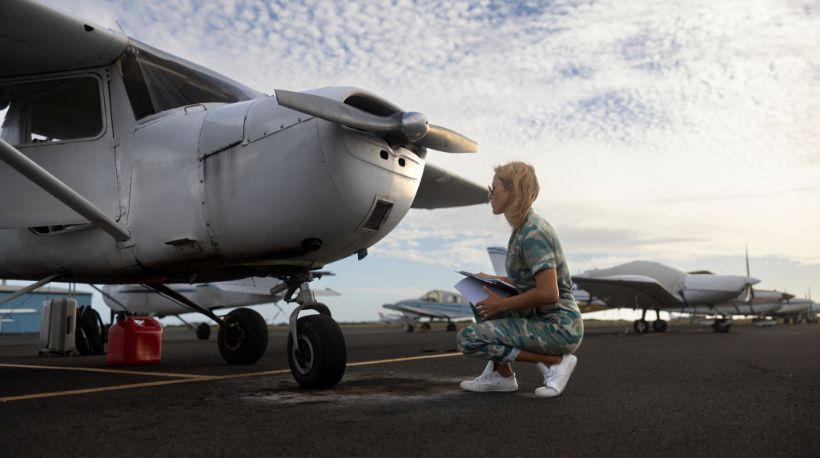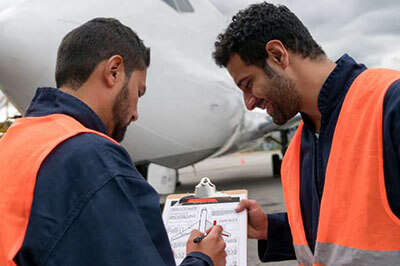While most pilots are familiar with pre-flight and post-flight inspections, adhering to a structured exterior and interior cleaning checklist can make a world of difference in the long-term performance of aircraft.

In This Article
- Preparation
- Wet & Wipe the Exterior
- Deep Clean Your Exterior
- Declutter Your Interior
- Vacuum
- Wipe Down Interior Surfaces
- Clean Out Drain Holes
- Clean Your Carpets
- Instrument Panel & Interior Plastic
- Leather Seats & Side Panels
- Clean Your Interior Windows
- The Final Touch
- FAQ: Aircraft Cleaning Checklist
When it comes to your aircraft, the importance of proper maintenance cannot be overstated. Beyond standard preventive maintenance and mechanical upkeep, cleanliness is an often overlooked yet crucial aspect of aircraft care. From maintaining a sleek appearance to preserving vital safety features, following an exterior and interior aircraft cleaning checklist is a responsibility all pilots and owners should take seriously.
Despite the differences in size and complexity compared to commercial passenger planes, general aviation aircraft require as much care, if not more, to ensure optimal performance and safety. The harsh sky elements, including exposure to UV rays, bird strikes and accumulated grime, can deteriorate an aircraft's appearance and compromise its structural integrity over time. This article'll provide a comprehensive aircraft cleaning checklist encompassing both the exterior and interior.
Step 1. Preparation: Getting Ready for the Task Ahead
Before diving into your aircraft cleaning checklist, it's crucial to be well-prepared for the job at hand. Begin by washing your hands thoroughly and removing any jewelry, especially rings. This precaution is essential since you'll be using your hands extensively during the cleaning process, and rings, in particular, can leave scratches and swirls on the aircraft's exterior, potentially damaging the paint.
Next, take the time to cover critical components such as the static ports, pitot tube, angle of attack sensor, etc., to prevent water from getting sprayed into them. However, attach some bright orange banner tape to each area you cover. This is a visual reminder to remove the covers once the cleaning is complete, as leaving critical ports or sensors covered before a flight can lead to disastrous consequences.
For the cleaning process, gather the necessary supplies, including plenty of clean water, microfiber towels and aircraft cleaning products. Using an aircraft-specific aluminum-safe degreaser, bug remover, wash soap and plexiglass cleaner is highly recommended for optimal results.
Step 2. Wet & Wipe the Exterior: Cleanliness for Safety & Efficiency
Maintaining a clean aircraft exterior goes beyond aesthetics; it directly impacts flight safety and efficiency. Dirt, grime and contaminants on an aircraft's exterior can disrupt airflow, reducing flying speed and increasing weight. Furthermore, these contaminants can corrode the aircraft's surface, posing potential risks to its structural integrity over time. Therefore, cleaning the aircraft exterior is fundamental to the aircraft cleaning checklist.
Start by using clean water to wet the entire aircraft exterior. A hose on a low setting works well for this purpose. Then, gently scrub the surface with an aircraft-specific wet wash shampoo and a non-scratch microfiber cloth. This process lets you control the pressure effectively, removing any debris stuck to the surface without damaging the paint. The plexiglass on the aircraft also requires attention. Use plexiglass wax to clean the glass, applying the same gentle technique as used on the paint.
Step 3. Deep Clean Your Exterior: Tackling Stubborn Contaminants
Once the initial wet-wiping is complete, you can move on to the next phase of your aircraft cleaning checklist by applying an aluminum-safe degreaser and/or bug remover to address stubborn contaminants in hard-to-reach areas. Ensure that you have thoroughly cleaned your exterior, then rinse everything off.
Step 4. Declutter Your Interior: Creating a Clean Slate
Now that the aircraft's exterior is well-taken care of shift your focus to the aircraft interior cleaning checklist. Begin by removing any clutter in the cockpit and seats. Grab a cardboard box and clear out loose items that aren't securely fastened.
Step 5. Vacuum: Getting Into Every Nook & Cranny
With the clutter removed, it's time to vacuum the interior thoroughly. Take a shop vac and access all possible aircraft floor areas. Pay particular attention to hard-to-reach spots around the rudder pedals, under the center console and below the rear seat. Proper vacuuming ensures no debris is left behind, preventing potential hazards during flight.
Step 6. Wipe Down All Interior Surfaces: Attending to Grease & Oil
With a clean slate to work from, it's time to delve into the nitty-gritty of the aircraft interior cleaning checklist. Use a rag and contact cleaner to identify and address areas with oil or grease, such as sticky floors from leaking components. Address any issues promptly to ensure the interior remains clean and free from unnecessary contaminants.

Step 7. Clean Out Drain Holes: Preventing Corrosion
The next step of your aircraft cleaning checklist is to locate all the drain holes in the fuselage and ensure they're clear. Blocked drain holes can trap standing water, leading to corrosion within the aircraft cabin. Use a simple pipe cleaner to clear any obstructions and ensure proper drainage.
Step 8. Clean Your Carpets: Restoring Freshness
Lay the aircraft's carpeting on a clean flat surface outside the aircraft and assess any work needed beyond vacuuming. Stains can often be removed with shop chemicals like WD-40, but test any cleaner on a small, inconspicuous section of the carpet or fabric before applying it to visible areas. Check for broken snaps or other minor issues that can be easily fixed before reinstalling the carpet.
Step 9. Wipe Down Your Instrument Panel & Interior Plastic: Rejuvenating the Interior
Moving on to the interior plastic and the instrument panel, select a suitable plastic and vinyl cleaner or protectant from the market. Avoid using glossy automotive products that could cause glare in the cockpit. Prep the surfaces and apply the cleaner or re-coloring agent to revitalize the plastic or vinyl components. For cleaning the glass faces of the instruments, apply the cleaner to a clean rag rather than spraying it directly on the panel or instruments.
Step 10. Care for Leather Seats & Side Panels: Preserve Comfort and Durability
If your aircraft has leather seats or side panels, investing in a high-end cleaning and preservative system is worthwhile to maintain its condition. Leather is susceptible to damage from sweat, spilled drinks and UV exposure, leading to drying and cracking over time. Choose premium leather products for high-end automotive and furniture leather, ensuring the final coating includes a UV protectant. Gently clean and spread the seat seams to remove dirt and grit, preventing premature wear and tear on the stitching.
Step 11. Clean Your Interior Windows: Clear Vision, Safe Flight
With other tasks of your aircraft interior cleaning checklist completed, it's time to clean the interior windows using an aviation-specific plexiglass cleaner. Remember to spray the cleaner on a clean rag rather than directly on the glass to avoid overspray throughout the cabin.
Step 12. Remove Covers & Replace Everything: The Final Touch
Congratulations! You've completed your comprehensive aircraft exterior and aircraft interior cleaning checklist. Now, replace everything you removed from the aircraft while cleaning (except for the clutter.) Remove all covers on sensors, ports and tubes, leaving your aircraft ready for its next flight.
Alternative Ways to Wash: Waterless Washing
Our exterior aircraft cleaning checklist highlighted the use of aircraft-specific shampoos that necessitate water. However, you can explore numerous alternative methods to achieve a spotless aircraft exterior. Discover the versatility of aircraft cleaning with our friends at Aero Cosmetics through this informative video demonstrating their revolutionary Wash Wax All product. This innovative solution promises a flawless clean with fewer steps, ensuring your aircraft shines with brilliance.
Frequently Asked Questions About Our Aircraft Cleaning Checklist
If you still have questions or need more information on our aircraft cleaning checklist, check out the answers to our most frequently asked questions below.
What Are the 3 Types of Aircraft Cleaning?
The three major types of aircraft cleaning refer to exterior cleaning. They include dry wash, wet wash and polishing.
What Is the FAA Requirement in Reference to Aircraft Cleaning?
The FAA mandates that preventive maintenance tasks for FAR 91, 121, and 135 operators must be completed and certified by a certified A&P mechanic to return to service under FAR part 43.3. Aircraft exterior cleaning is listed in the manufacturer's maintenance manuals, requiring an A&P mechanic's involvement and logbook signature. Part 91 pilots/owners can clean their aircraft, but anyone else must hold an A&P/AMT certificate to do so. Complying with these guidelines ensures aircraft safety and airworthiness.
Do I Need to Wear PPE When Washing My Aircraft?
Yes! When washing your aircraft, it's essential to prioritize safety to protect yourself from potential hazards. Protective clothing, chemical-resistant gloves, safety glasses and dust masks are all recommended PPE for washing an aircraft.
Complete Your Aircraft Cleaning Checklist With Cleaning Supplies From Air Power Inc.
Get your aircraft cleaning checklist complete with top-quality supplies from Air Power Inc.! We proudly offer a wide range of Aero Cosmetics products, including aircraft shampoo, plexiglass cleaner, interior cleaner, leather soap and much more, all at the best prices in the industry. Don't compromise on the cleanliness and safety of your aircraft – shop the best cleaning supplies available at Air Power Inc. today.
Shop All Cleaning Supplies
Related Articles: Aircraft Cleaning Checklist
The 7 Basic Parts of an Airplane & Their Main Functions
Aircraft Preventive Maintenance & Inspection Checklists
Top Benefits of Financing an Airplane Engine Purchase


